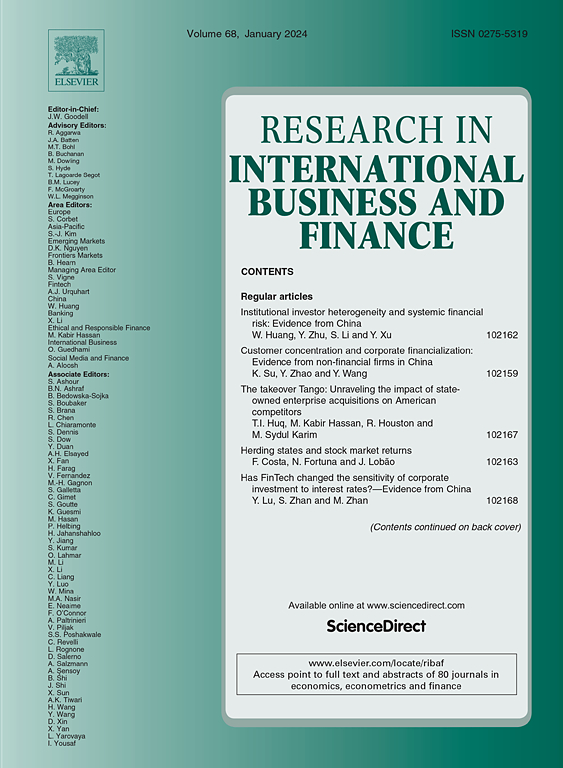探索非线性尾部依赖关系:货币变化中的加密货币、稳定币和大宗商品市场
IF 6.9
2区 经济学
Q1 BUSINESS, FINANCE
Research in International Business and Finance
Pub Date : 2025-03-19
DOI:10.1016/j.ribaf.2025.102874
引用次数: 0
摘要
本研究探讨了主要加密货币、稳定币和各种商品市场的非线性尾部依赖和尾部风险。为了实现这一目标,我们在两个不同时期采用了一种新的非线性尾部依赖度量:2020年1月3日至2021年12月31日由covid -19引发的货币扩张,以及随后从2022年1月1日至2022年9月14日的货币收缩。与之前的研究不同,这项研究独特地考虑了左右尾巴以及稳定币和主要加密货币之间的相互作用。我们的研究结果显示,在货币扩张和收缩期间,主要加密货币和大宗商品市场之间存在显著且持续的上下尾依赖关系。我们还观察到,在这些时期,大多数稳定币和大宗商品市场之间存在一致的上下尾依赖关系。此外,我们的分析强调了商品市场对加密货币表现的预测能力。重要的是,我们的研究结果挑战了稳定币作为避险资产的普遍观点,提供了与先前研究不同的新视角。对于在不同货币政策体系中分散投资组合的投资者来说,这些见解非常宝贵。本文章由计算机程序翻译,如有差异,请以英文原文为准。
Exploring nonlinear tail dependencies: Cryptocurrencies, stablecoins, and commodity markets amid monetary shifts
This study explores the nonlinear tail dependence and tail risk in major cryptocurrencies, stablecoins, and various commodity markets. To achieve this, we apply a novel measure of nonlinear tail dependence across two distinct periods: the COVID-19-induced monetary expansion from January 3, 2020, to December 31, 2021, and the subsequent monetary contraction from January 1, 2022, to September 14, 2022. Unlike previous studies, this research uniquely considers both the right and left tails and the interactions between stablecoins and major cryptocurrencies. Our findings reveal a significant and persistent upper and lower tail dependence between major cryptocurrencies and commodity markets during both the monetary expansion and contraction periods. We also observe consistent upper and lower tail dependence between most stablecoins and commodity markets throughout these periods. Additionally, our analysis underscores the predictive power of commodity markets concerning cryptocurrency performance. Importantly, our results challenge the prevailing view that stablecoins function as safe-haven assets, offering a fresh perspective that diverges from prior research. These insights are precious for investors who diversify their portfolios across different monetary policy regimes.
求助全文
通过发布文献求助,成功后即可免费获取论文全文。
去求助
来源期刊

Research in International Business and Finance
BUSINESS, FINANCE-
CiteScore
11.20
自引率
9.20%
发文量
240
期刊介绍:
Research in International Business and Finance (RIBAF) seeks to consolidate its position as a premier scholarly vehicle of academic finance. The Journal publishes high quality, insightful, well-written papers that explore current and new issues in international finance. Papers that foster dialogue, innovation, and intellectual risk-taking in financial studies; as well as shed light on the interaction between finance and broader societal concerns are particularly appreciated. The Journal welcomes submissions that seek to expand the boundaries of academic finance and otherwise challenge the discipline. Papers studying finance using a variety of methodologies; as well as interdisciplinary studies will be considered for publication. Papers that examine topical issues using extensive international data sets are welcome. Single-country studies can also be considered for publication provided that they develop novel methodological and theoretical approaches or fall within the Journal''s priority themes. It is especially important that single-country studies communicate to the reader why the particular chosen country is especially relevant to the issue being investigated. [...] The scope of topics that are most interesting to RIBAF readers include the following: -Financial markets and institutions -Financial practices and sustainability -The impact of national culture on finance -The impact of formal and informal institutions on finance -Privatizations, public financing, and nonprofit issues in finance -Interdisciplinary financial studies -Finance and international development -International financial crises and regulation -Financialization studies -International financial integration and architecture -Behavioral aspects in finance -Consumer finance -Methodologies and conceptualization issues related to finance
 求助内容:
求助内容: 应助结果提醒方式:
应助结果提醒方式:


